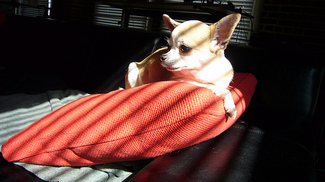Pets with Seasonal Affective Disorder may have a new option in mitigating symptoms of the winter duldrums

flickr photo by tv42
The gloomy days can wreak havoc on our bodies and our mood just the same.
Seasonal Affective Disorder, or SAD, is a definitive term used to refer to those symptoms associated with the lack of sunshine. Lethargy, unhappiness, irritability as well as an increase in the desire to sleep are just a few.
You might be surprised to learn that SAD affects animals as well. Dr. Alice M. Jeromin, RPh, DVM, Dipl. ACVD has written about how it's thought to contribute one type of hair loss in dogs.
Are you skeptical about the concept of dogs and cats dealing with SAD?
Many researchers indicate that although we don't really know what a pet is experiencing, they are mammals, just like us, and they are affected by the same mammalian hormones, like melatonin. Melatonin has the ability to regulate biological rhythms, among other things.
Melatonin is produced by the pineal gland — and is inhibited by light to the retina, and it increases in production by darkness.
With the shorter days in the winter and subsequent higher level of melatonin, it can be a little challenging to try and combat the winter blahs that result for both humans and pets alike, and getting outdoors for a fair amount of time can be next to impossible.
Symptoms in pets typically manifest in behavioral changes like aggression, inappropriate soiling, lethargy, neediness and more.
One way to address SAD in humans — the use of a light box — has garnered interest for use in mitigating the effects of the disorder in pets.
A company out of Portland, Ore. now sells light boxes specially designed for companion animals.
Max Marvin, owner of Pawsitive Lighting, came up with the idea for the boxes after using a light box in his own battle with severe insomnia several years ago.
The premise behind the light box is that it mimics the sun by radiating artificial sunlight to an indoor space. Thus, it helps to balance the production of melatonin, which aids in correcting problems with the sleep cycle and mood.
After using the light box and getting good results, Marvin noticed something: his dog seemed to benefit from it too.
Marvin then decided to forge ahead and partner with a light-therapy device manufacturer in the UK to develop the Sol Box, a light box designed for dogs and cats.
The unit, priced at around $200, delivers 10,000 lux to your pet, and is recommended for use for about 35-45 minutes per day.
Do you feel that your pet is affected by the lack of sunlight? What kinds of changes have you observed in your furry pal?
Click here to read more on SAD in pets.
Lorrie Shaw leads the pets section for AnnArbor.com and is a professional pet sitter. Connect with her on Google + or e-mail her directly.


Comments
RunsWithScissors
Fri, Dec 28, 2012 : 12:57 p.m.
I have the luxury of working from home and thus can step out midday for a walk with my dog. My cats, however, would prefer to stay inside where it's warm. I have noticed one of my cats acting a little flat (for lack of a better word) in that he doesn't show the same interest in life that he used to. Maybe I'll check out the use of a light box. Thanks for the info.